Popular on Food52
Continue After Advertisement
18 Comments
Amy
February 19, 2022
Hello,
I appreciate this recipe, thank you. I’ll make it soon ;)
You said “elasticity, which means it's easier to stretch the dough without breaking it.”
The correct word in reference to dough would be extensibility. A definition of stretch is extend.
Dough elasticity refers to a dough’s tendency to shrink after being rolled or stretched. Like a piece of elastic.
I appreciate this recipe, thank you. I’ll make it soon ;)
You said “elasticity, which means it's easier to stretch the dough without breaking it.”
The correct word in reference to dough would be extensibility. A definition of stretch is extend.
Dough elasticity refers to a dough’s tendency to shrink after being rolled or stretched. Like a piece of elastic.
Emiko
February 19, 2022
Thank you so much for the correction, this is something I will endeavour to fix in the future!
Alex M.
January 4, 2017
This turned out AMAZING! I could not find crescenza or stracchino cheese anywhere, but substituted with taleggio and ricotta and it was absolutely delicious. I topped the finished focaccia with flaky sea salt and a drizzle of truffle oil....perfection.
portofinocoast
August 7, 2015
Very tasty! If you like Ligurian Recipes, you should take a look to our website: http://www.portofinocoast.it/en/enogastronomia.aspx ;)
Mary E.
May 4, 2015
Emiko,
I stayed in Camogli, the town next to Recco, for a week and ate Focaccia col formaggio almost every day. I got the recipe from Manuelina and tried it when I got home. After many attempts, I'm still trying to get it right. The two biggest challenges are getting the dough thin enough and finding Crescenza cheese. I live in the Chicago area, and the nearest source is Bellwether Farms in California! The shipping costs were as much as the cheese, so I am still looking for a good alternative. Fortunately, there is a restaurant in Chicago that has it on the menu -- Davanti Enoteca -- and it is almost exactly like in Recco (lucky me)! Your article has inspired me to try making again...or maybe I'll just go back to Recco!
I stayed in Camogli, the town next to Recco, for a week and ate Focaccia col formaggio almost every day. I got the recipe from Manuelina and tried it when I got home. After many attempts, I'm still trying to get it right. The two biggest challenges are getting the dough thin enough and finding Crescenza cheese. I live in the Chicago area, and the nearest source is Bellwether Farms in California! The shipping costs were as much as the cheese, so I am still looking for a good alternative. Fortunately, there is a restaurant in Chicago that has it on the menu -- Davanti Enoteca -- and it is almost exactly like in Recco (lucky me)! Your article has inspired me to try making again...or maybe I'll just go back to Recco!
woo W.
March 31, 2015
Hi, I love Focaccia di Recco. I think the other commentors are taking umbrage at the dipping part of the focaccia and cappuccino reference (I originally was thinking it was focaccia di Recco which brought mind to a fondue latte I once saw advertised in Hong Kong but I digress).
Having spent 20 years visiting and living in Liguria, I would say that they all have bread (including leftover focaccia), fette biscottate and biscuits around the house that they eat at home for breakfast (at the bar more likely a brioche). Do they dip the focaccia (the biscuits and fette biscottate for sure they do)? I mean who knows what people do behind closed doors.
What I would say is that a Ligurian friend's father (who would be 105 years old if still alive) used to dip his bread in his wine which is apparently something which was common in the past and no longer nowadays. I imagine he must have at least tried the focaccia cappuccino combination (he certainly wouldn't be upset by the idea). The mention of not eating something would invite him to reminisce about the war and how scarce food was. Next time I am in Liguria, I'll try it and let you know.
Having spent 20 years visiting and living in Liguria, I would say that they all have bread (including leftover focaccia), fette biscottate and biscuits around the house that they eat at home for breakfast (at the bar more likely a brioche). Do they dip the focaccia (the biscuits and fette biscottate for sure they do)? I mean who knows what people do behind closed doors.
What I would say is that a Ligurian friend's father (who would be 105 years old if still alive) used to dip his bread in his wine which is apparently something which was common in the past and no longer nowadays. I imagine he must have at least tried the focaccia cappuccino combination (he certainly wouldn't be upset by the idea). The mention of not eating something would invite him to reminisce about the war and how scarce food was. Next time I am in Liguria, I'll try it and let you know.
munnezzaglia
March 25, 2015
Emiko,
I enjoy reading your blog but I live down the via Aurelia from Recco and I assure you that Ligurians do not customarily dip their breakfast foccacia into cappuccino. Also, while Recco certainly deserves to claim the cheesy foccacia as its own, the true name is foccacia col formaggio, and this is how it is known among Ligurians
There is a nice youtube from Manuelina in Recco that shows the process of making it. You can see that one does not brush olive oil atop the pastry before baking but poured or drizzled on top.
https://www.youtube.com/watch?v=0bCiUReZvU4
Finally, to correct the "legend": The people of Recco lived near the sea and were vulnerable to pirate raids from the Saracen pirates. They built towers in the hills to watch the sea, and if they saw pirate ships, they alerted the town to run to the hills. The people of Recco would grab their oil, their flour and sale, and their cheese (or animals), and run to hide. They survived on this dish until the pirates finished looting Recco and left, and the residents would return to their homes by the sea -- or so the legend goes.
I enjoy reading your blog but I live down the via Aurelia from Recco and I assure you that Ligurians do not customarily dip their breakfast foccacia into cappuccino. Also, while Recco certainly deserves to claim the cheesy foccacia as its own, the true name is foccacia col formaggio, and this is how it is known among Ligurians
There is a nice youtube from Manuelina in Recco that shows the process of making it. You can see that one does not brush olive oil atop the pastry before baking but poured or drizzled on top.
https://www.youtube.com/watch?v=0bCiUReZvU4
Finally, to correct the "legend": The people of Recco lived near the sea and were vulnerable to pirate raids from the Saracen pirates. They built towers in the hills to watch the sea, and if they saw pirate ships, they alerted the town to run to the hills. The people of Recco would grab their oil, their flour and sale, and their cheese (or animals), and run to hide. They survived on this dish until the pirates finished looting Recco and left, and the residents would return to their homes by the sea -- or so the legend goes.
Emiko
March 25, 2015
Thanks for your thought. I have no doubt that you know plenty about this subject, I admit that it's a rather new discovery to me but I did also do SO MUCH research before testing and writing this recipe and article and I take pride in the work I do for this column (as it's also a passion of mine). I know it's known as focaccia col formaggio in Liguria but outside of Liguria, including in the rest of Italy, it is more famously known as focaccia di Recco and so this is the name I wanted to introduce this dish as, naturally. I've read plenty of different stories on the legend of this focaccia's origins -- I must say I do like yours (which I also found through A. Molinari Pradelli's, “La cucina ligure”, 2003), though I wouldn't necessarily say it needs to be "corrected", more like "added" to the stories behind this great dish (that is was the beauty of legends is all about, right?). This version that I described is one I read most about. Finally, I do believe there are many Ligurians who like to dip their focaccia in cappuccino -- I've read it in plenty of reliable sources (plus I know a few who do! It may not be something that everyone does but I wanted to illustrate how it's eaten throughout the day, from breakfast to aperitivo). Here's an example: http://viaggi.corriere.it/viaggi/weekend/gusto/2013/marzo/genova-focaccia.shtml
Christine
March 16, 2015
Made this and it was delicious! It was a little salty, so I would reduce the salt. The mozzarella was fine and I can only imagine what it must taste like with a good cheese. I did make the dough and let it rest in the fridge. It was easy to make it the next day when I was in a hurry.
Alexandra K.
March 4, 2015
At one of our favorite restaurants, this is served with local wild honeycomb. The combination of the crispy dough, the salty creamy cheese, and honeycomb is my favorite.
amysarah
March 4, 2015
This is definitely on my to-do list. It looks somewhat like a delicious Georgian flat bread I've made, though that one uses yeast and is richer, with milk and a fair amount of butter in the dough. The filling there is a combo of mozzarella and goat cheese - maybe that would be a good cheese sub here too.
Christine
January 4, 2017
I would love your recipe for Georgian flat bread. We spent some time in Siberia this summer and had the most delicious Georgian food. I can't stop thinking about it!
cucina D.
March 4, 2015
this is really beautiful, I am not familiar but my famiglia is from Roma and Sorrento (amalfi coast) regions where breakfast is cornetto con espresso or even fish dishes left over from the night before. I will need to try this one, I would love this for lunch with greens and sliced proscuitto
Ilaria
March 4, 2015
Just one or two advices from a Ligurian:
1- add a little bit of white wine in the pastry
2- once the dough is made, put it in the fridge for some hours (better for a day), and it will become very easy to stretch it. It's also ok to make a lot of dough and put it in the freezer.
3- mix the cheese with a little bit of milk.
:)
1- add a little bit of white wine in the pastry
2- once the dough is made, put it in the fridge for some hours (better for a day), and it will become very easy to stretch it. It's also ok to make a lot of dough and put it in the freezer.
3- mix the cheese with a little bit of milk.
:)
Christine
March 3, 2015
Is there another substitute for the cheese? Sacrilegious, I am sure.
Living in the middle of nowhere has its disadvantages.
Living in the middle of nowhere has its disadvantages.
Emiko
March 3, 2015
Yes, any good (preferably soft) melting cheese could probably do -- mozzarella might be the next best bet. If using fresh balls of mozzarella, dice it and let it drain of excess liquid before using it otherwise it will make the base soggy.
Andrea F.
March 3, 2015
Delicious!
(Focaccia Genovese with cappuccino? Are you kidding? An Italian could choke to death for that! ;)
(Focaccia Genovese with cappuccino? Are you kidding? An Italian could choke to death for that! ;)
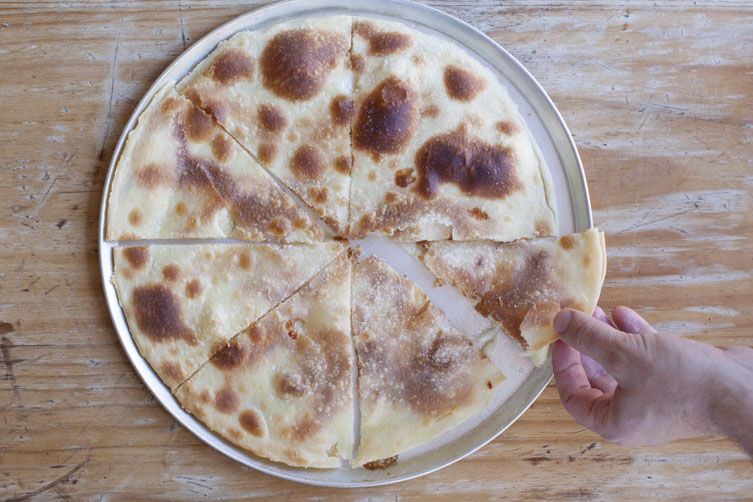

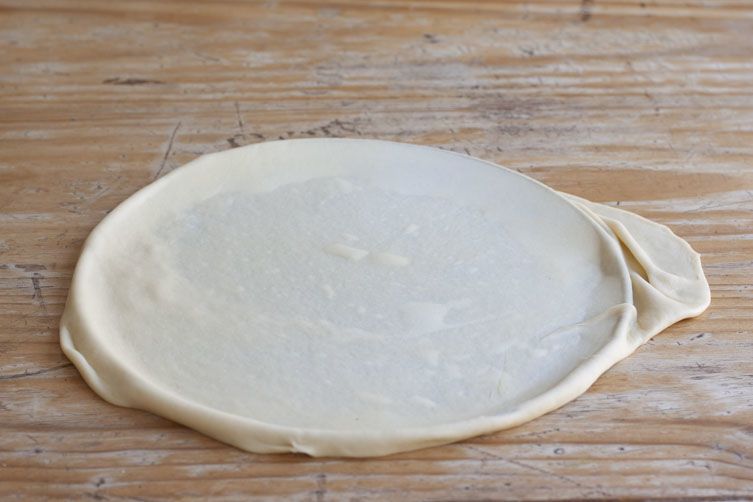
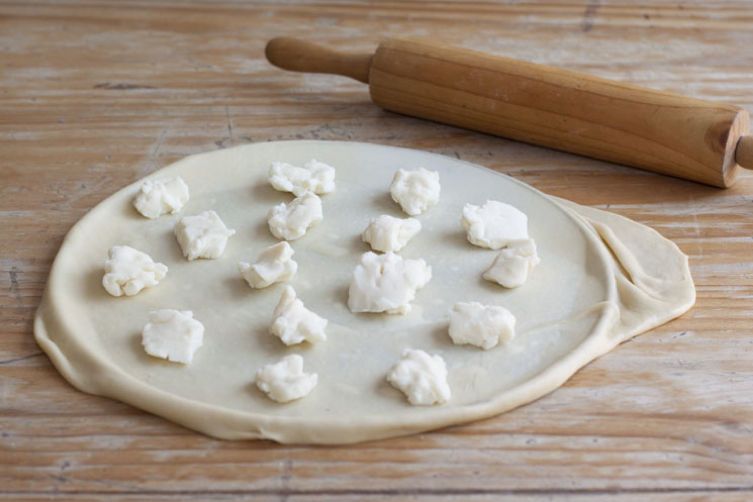
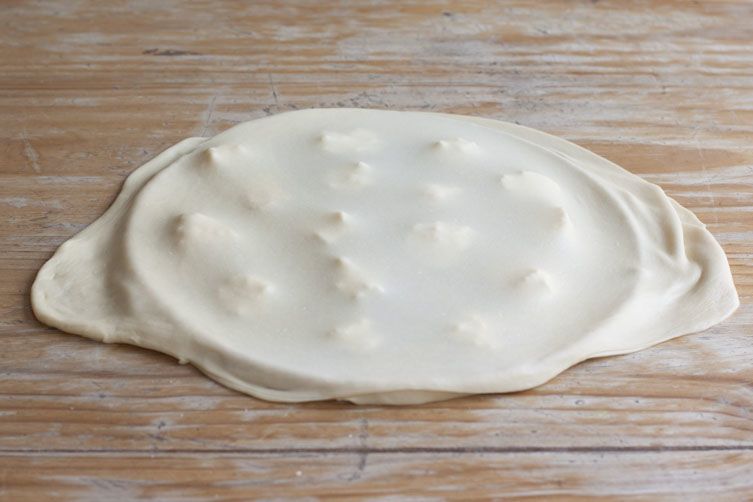
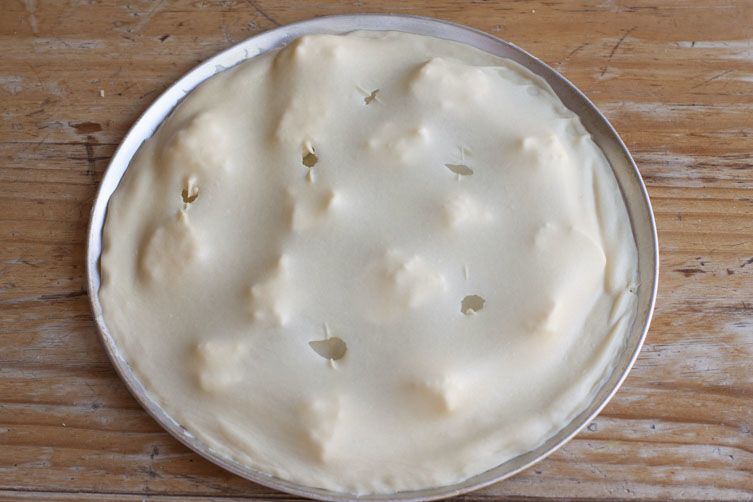
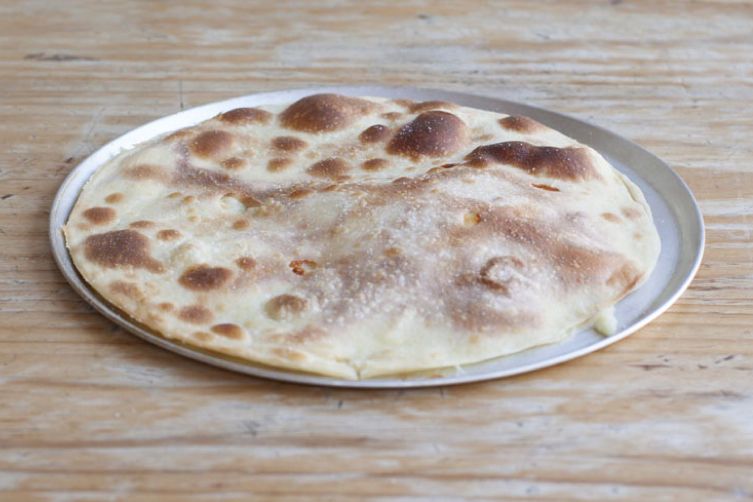

See what other Food52 readers are saying.